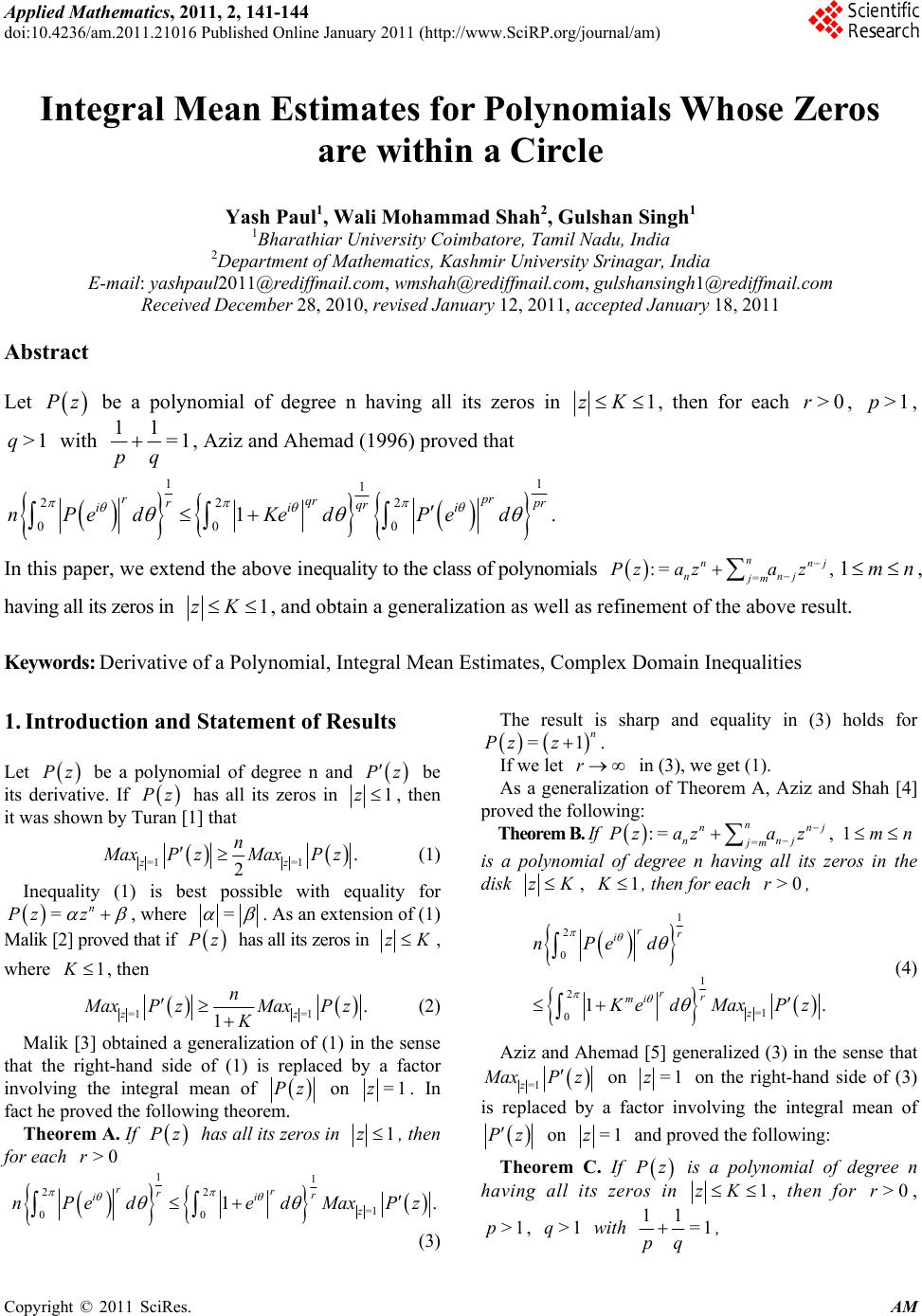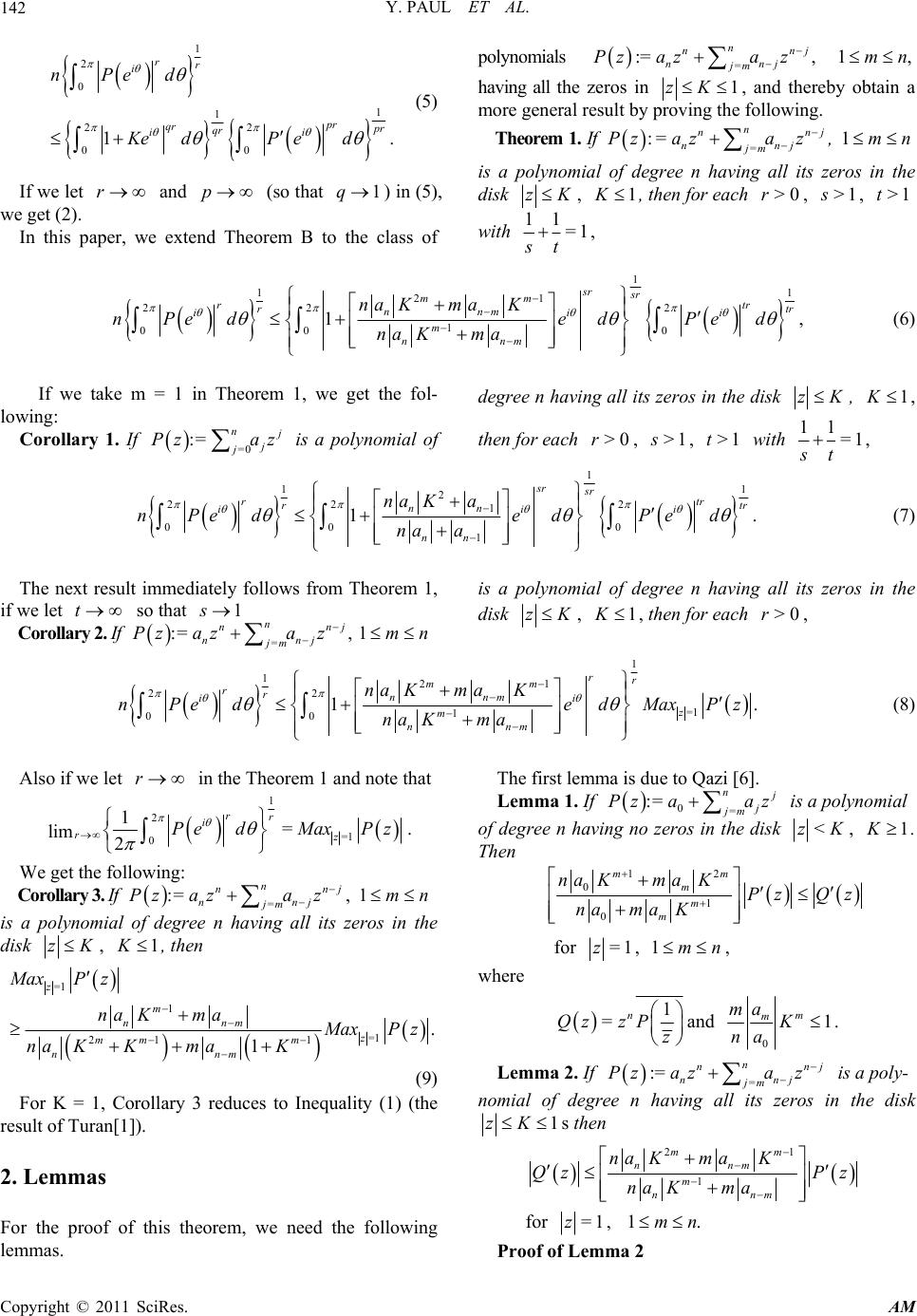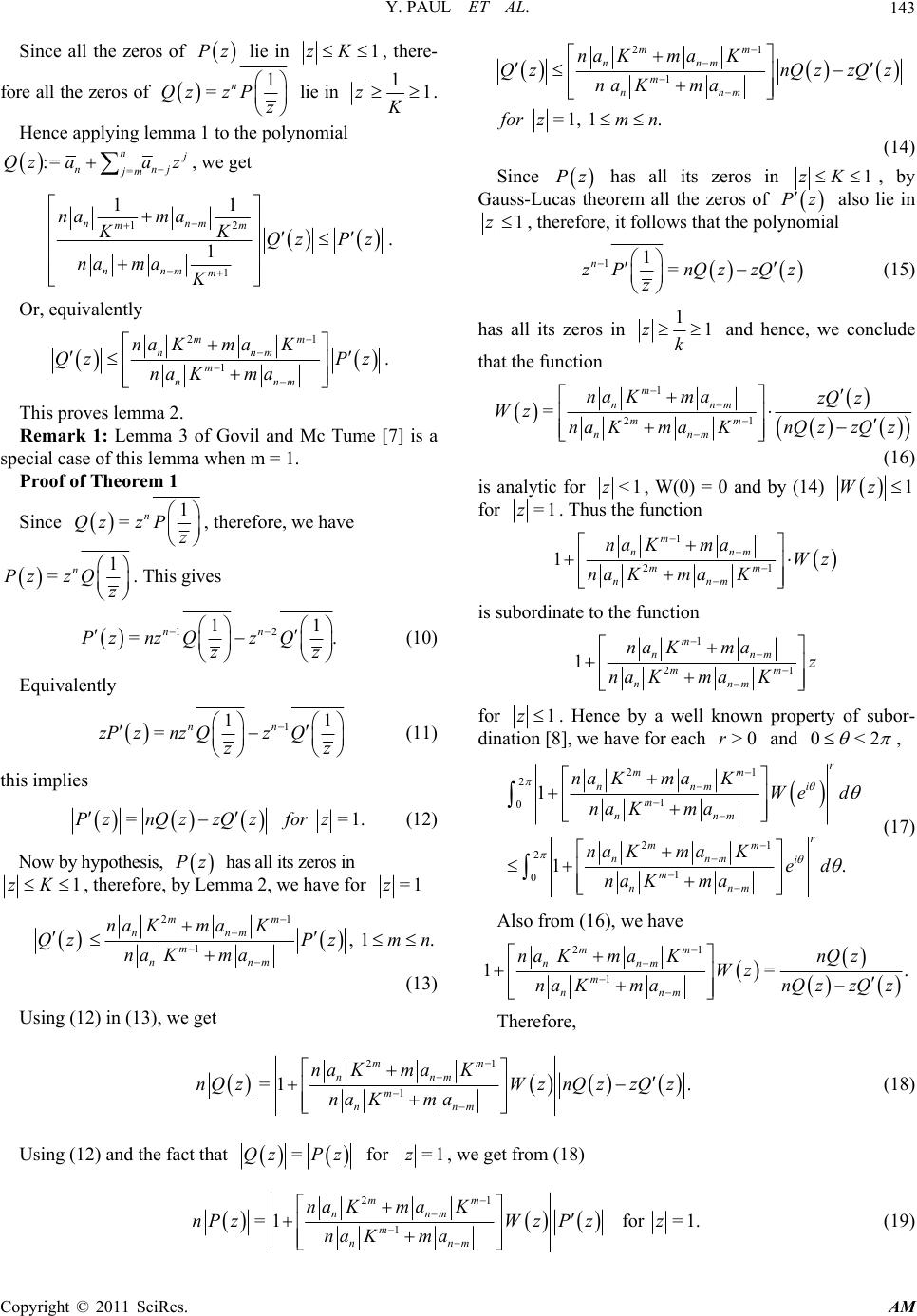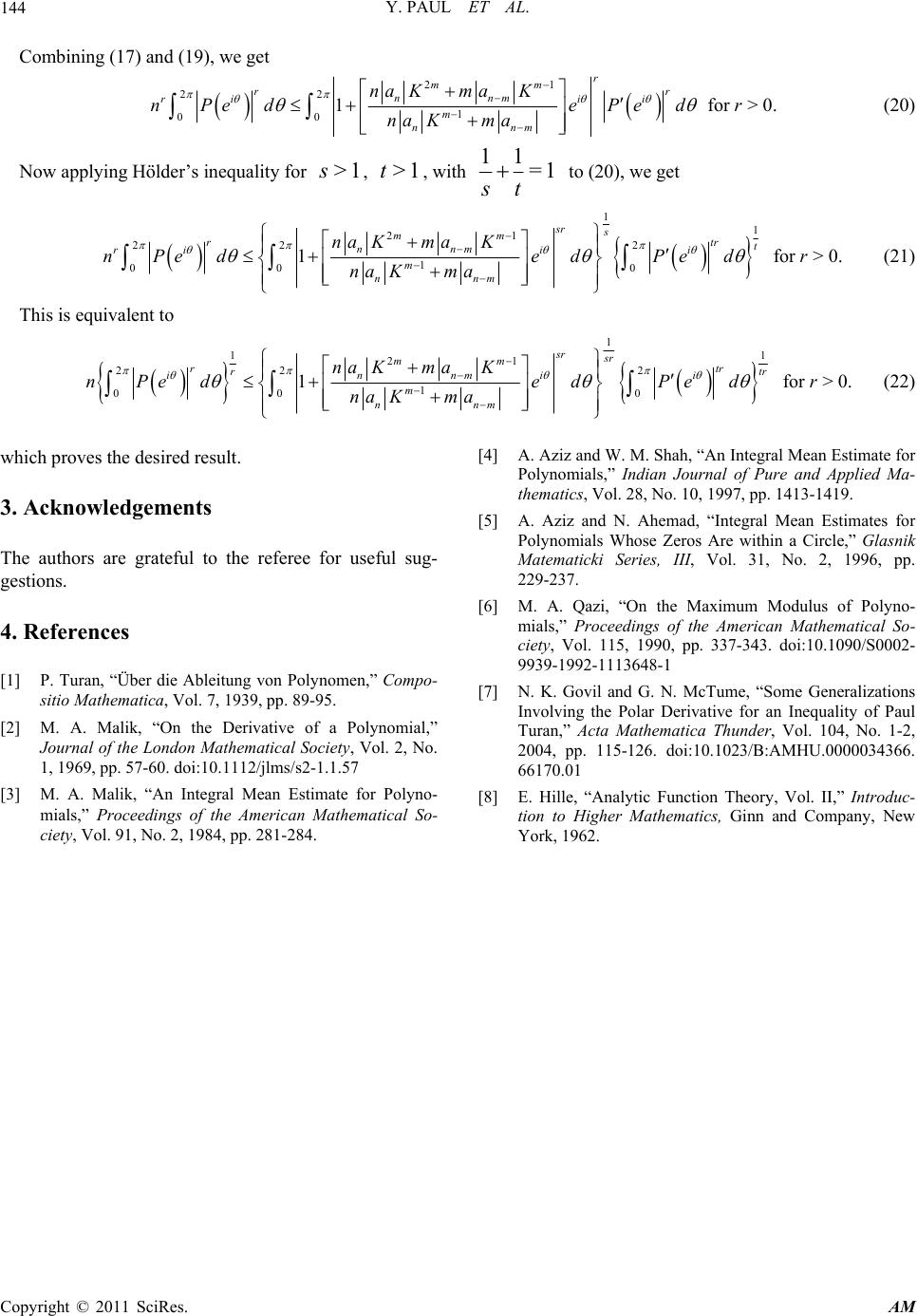Paper Menu >>
Journal Menu >>
 Applied Mathematics, 2011, 2, 141-144 doi:10.4236/am.2011.21016 Published Online January 2011 (http://www.SciRP.org/journal/am) Copyright © 2011 SciRes. AM Integral Mean Estimates for Polynomials Whose Zeros are within a Circle Yash Paul1, Wali Mohammad Shah2, Gulshan Singh1 1Bharathiar University Coimbatore, Tamil Nadu, India 2Department of Mat hem at i cs, K ash mi r Uni versity Srinagar , In di a E-mail: yashpaul2011@rediffmail.com, wmshah@rediffmail.com, gulshan si ng h 1@rediffmail.com Received December 28, 2010, revised January 12, 2011, accepted January 18, 2011 Abstract Let Pz be a polynomial of degree n having all its zeros in 1zK , then for each >0r, >1p, >1q with 11 =1 pq , Aziz and Ahemad (1996) proved that 11 1 22 2 00 0 1. rpr qr rpr qr iii nPedKed Ped In this paper, we extend the above inequality to the class of polynomials = := , n nnj nnj jm Pzaza z 1mn , having all its zeros in 1zK, and obtain a generalization as well as refinement of the above result. Keywords: Derivative of a Polynomial, Integral Mean Estimates, Complex Domain Inequalities 1. Introduction and Statement of Results Let Pz be a polynomial of degree n and Pz be its derivative. If Pz has all its zeros in 1z , then it was shown by Turan [1] that =1=1 . 2 zz n M axPzMaxP z (1) Inequality (1) is best possible with equality for =n Pz z , where = . As an extension of (1) Malik [2] proved that if Pz has all its zeros in zK , where 1K, then =1=1 . 1 zz n M axPzMaxP z K (2) Malik [3] obtained a generalization of (1) in the sense that the right-hand side of (1) is replaced by a factor involving the integral mean of Pz on =1z. In fact he proved the following theorem. Theorem A. If Pz has all its zeros in 1z , then for each >0r 11 22 =1 00 1. rr rr ii z nPed edMaxPz (3) The result is sharp and equality in (3) holds for =1 n Pz z . If we let r in (3), we get (1). As a generalization of Theorem A, Aziz and Shah [4] proved the following: Theorem B. If = := n nnj nnj jm Pzaza z , 1mn is a polynomial of degree n having all its zeros in the disk zK , 1 K , then for each >0r, 1 2 0 1 2 =1 01. rr i rr mi z nPed K ed MaxPz (4) Aziz and Ahemad [5] generalized (3) in the sense that =1z M axP z on =1z on the right-hand side of (3) is replaced by a factor involving the integral mean of P z on =1z and proved the following: Theorem C. If Pz is a polynomial of degree n having all its zeros in 1zK, then for >0r, >1p, >1q with 11 =1 pq ,  Y. PAUL ET AL. Copyright © 2011 SciRes. AM 142 1 2 0 1 1 22 00 1. rr i pr qr p r qr ii nPed KedP ed (5) If we let r and p (so that 1q) in (5), we get (2). In this paper, we extend Theorem B to the class of polynomi als = := , n nnj nnj jm Pzazaz 1,mn having all the zeros in 1zK , and thereby obtain a more general result by proving the following. Theorem 1. If = := n nnj nnj jm Pzaza z , 1mn is a polynomial of degree n having all its zeros in the disk zK , 1K , then for each >0r, >1s, >1t with 11 =1 s t , 1 1 1 21 22 2 1 00 0 1, sr sr mm rtr rtr nnm iii m nnm na KmaK nPeded Ped na Kma (6) If we take m = 1 in Theorem 1, we get the fol- lowing: Corollary 1. If =0 := n j j j Pz az is a polynomial of degree n having all its zeros in the disk zK, 1K , then for each >0r, >1s, >1t with 11 =1 s t , 1 1 1 2 22 2 1 00 0 1 1. sr sr rtr rtr nn iii nn na Ka nPeded Ped na a (7) The next result immediately follows from Theorem 1, if we let t so that 1s Corollary 2. If = := , n nnj nnj jm Pzaza z 1mn is a polynomial of degree n having all its zeros in the disk zK , 1 K , then for each >0r, 1 121 22 =1 1 00 1. rr mm rrnnm ii z m nnm na KmaK nPed edMaxPz na Kma (8) Also if we let r in the Theorem 1 and note that 1 2 =1 0 1= lim 2 rr i rz PedMax Pz . We get the following: Corollary 3. If = := n nnj nnj jm Pzaza z , 1mn is a polynomial of degree n having all its zeros in the disk zK, 1 K , then =1 1 =1 211 . 1 z m nnm z mm m nnm MaxP z na Kma M axP z na KKmaK (9) For K = 1, Corollary 3 reduces to Inequality (1) (the result of Turan[1]) . 2. Lemmas For the proof of this theorem, we need the following lemmas. The first lemma is due to Qazi [6]. Lemma 1. If 0= := n j j jm Pz aaz is a polynomial of degree n having no zeros in the disk <zK, 1K. Then 12 0 1 0 mm m m m na KmaKPz Qz nama K for =1z, 1mn , where 1 =n QzzP z and 0 1 m m a mK na . Lemma 2. If = := n nnj nnj jm Pzaza z is a poly- nomial of degree n having all its zeros in the disk 1zK s then 21 1 mm nnm m nnm na KmaK Qz Pz na Kma for =1z, 1.mn Proof of Lemma 2  Y. PAUL ET AL. Copyright © 2011 SciRes. AM 143 Since all the zeros of Pz lie in 1zK, there- fore all the zeros of 1 =n QzzP z lie in 11z K . Hence applying lemma 1 to the polynomial = := n j nnj jm Qzaa z , we get 12 1 11 1 nnm mm nnm m na ma KK Qz Pz na maK . Or, equivalently 21 1 mm nnm m nnm na KmaK Qz Pz na Kma . This proves lemma 2. Remark 1: Lemma 3 of Govil and Mc Tume [7] is a special case of this lemma when m = 1. Proof of Theorem 1 Since 1 =n QzzP z , therefore, we have 1 =n PzzQ z . This gives 12 11 =. nn Pznz QzQ zz (10) Equivalently 1 11 =nn zPznz QzQ zz (11) this implies = =1.PznQz zQzforz (12) Now by hypothesis, Pz has all its zeros i n 1zK, therefore, by Lemma 2, we have for =1z 21 1, 1. mm nnm m nnm na KmaK QzPzm n na Kma (13) Using (12) in (13), we get 21 1 =1, 1. mm nnm m nnm na KmaK QznQz zQz na Kma for zmn (14) Since Pz has all its zeros in 1zK , by Gauss-Lucas theorem all the zeros of Pz also lie in 1z , therefore, it follows that the polynomial 11= n zPnQzzQz z (15) has all its zeros in 11zk and hence, we conclude that the function 1 21 =m nnm mm nnm na KmazQ z Wz na KmaKnQ zzQz (16) is analytic for <1z, W(0) = 0 and by (14) 1Wz for =1z. Thus the function 1 21 1m nnm mm nnm na KmaWz na KmaK is subordinate to the function 1 21 1m nnm mm nnm na Kmaz na KmaK for 1z . Hence by a well known property of subor- dination [8], we have for eac h >0r and 0<2 , 21 2 1 0 21 2 1 0 1 1. r mm nnm i m nnm r mm nnm i m nnm na KmaKWe d naKma na KmaKed na Kma (17) Also from (16), we have 21 1 1=. mm nnm m nnm na KmaKnQ z Wz nQ zzQz na Kma Therefore, 21 1 =1 . mm nnm m nnm na KmaK nQ zWznQ zzQz na Kma (18) Using (12) and the fact that =QzPz for =1z, we get from (18) 21 1 =1for =1. mm nnm m nnm na KmaK nP zWzPzz na Kma (19)  Y. PAUL ET AL. Copyright © 2011 SciRes. AM 144 Combining (17) and (19), we get 21 22 1 00 1 for >0. r mm r r nnm ri ii m nnm na KmaK n PedePedr na Kma (20) Now applying Hölder’s inequality for 1>s, 1>t, with 1= 11 ts to (20), we get 11 21 22 2 1 00 0 1 for >0. sr s mm rtr t nnm rii i m nnm na KmaK nPededPedr na Kma (21) This is equivalent to 1 1 1 21 22 2 1 00 0 1 for >0. sr sr mm rtr rtr nnm iii m nnm na KmaK nPededPedr na Kma (22) which proves the desired resu lt. 3. Acknowledgements The authors are grateful to the referee for useful sug- gestions. 4. References [1] P. Turan, “Über die Ableitung von Polynomen,” Compo- sitio Mathematica, Vol. 7, 1939, pp. 89-95. [2] M. A. Malik, “On the Derivative of a Polynomial,” Journal of the London Mathematical Society, Vol. 2, No. 1, 1969, pp. 57-60. doi:10.1112/jlms/s2-1.1.57 [3] M. A. Malik, “An Integral Mean Estimate for Polyno- mials,” Proceedings of the American Mathematical So- ciety, Vol. 91, No. 2, 1984, pp. 281-284. [4] A. Aziz and W. M. Shah, “An Integral Mean Estimate for Polynomials,” Indian Journal of Pure and Applied Ma- thematics, Vol. 28, No. 10, 1997, pp. 1413-1419. [5] A. Aziz and N. Ahemad, “Integral Mean Estimates for Polynomials Whose Zeros Are within a Circle,” Glasnik Matematicki Series, III, Vol. 31, No. 2, 1996, pp. 229-237. [6] M. A. Qazi, “On the Maximum Modulus of Polyno- mials,” Proceedings of the American Mathematical So- ciety, Vol. 115, 1990, pp. 337-343. doi:10.1090/S0002- 9939-1992-1113648-1 [7] N. K. Govil and G. N. McTume, “Some Generalizations Involving the Polar Derivative for an Inequality of Paul Turan,” Acta Mathematica Thunder, Vol. 104, No. 1-2, 2004, pp. 115-126. doi:10.1023/B:AMHU.0000034366. 66170.01 [8] E. Hille, “Analytic Function Theory, Vol. II,” Introduc- tion to Higher Mathematics, Ginn and Company, New York, 1962. |

